Efficiency Assessment of Traditional GaAs and Low-Power InGaAs Schottky Diodes in Full-Band Mixers at 0.3 THz
Abstract
:1. Introduction
2. GaAs Mixer
2.1. Measurements Setup
2.2. Conversion Loss and Power Requirement Measurements
2.3. Noise Temperature Measurements
2.4. Simulations vs. Measurements
3. Low-Barrier Mixer
3.1. Conversion Loss and Power Requirement Measurements
3.2. Noise Temperature Measurements
3.3. Simulations vs. Measurements
4. GaAs and InGaAs Diode Mixer Performance Comparison
5. Conclusions
Author Contributions
Funding
Conflicts of Interest
References
- Nagatsuma, T.; Fujita, Y.; Yasuda, Y.; Kanai, Y.; Hisatake, S.; Fujiwara, M.; Kani, J. Real-time 100-Gbit/s QPSK transmission using photonics-based 300-GHz-band wireless link. In Proceedings of the 2016 IEEE International Topical Meeting on Microwave Photonics (MWP), Long Beach, CA, USA, 31 October–3 November 2016; pp. 27–30. [Google Scholar]
- Hamada, H.; Fujimura, T.; Abdo, I.; Okada, K.; Song, H.-J.; Sugiyama, H.; Matsuzaki, H.; Nosaka, H. 300-GHz. 100-Gb/s InP-HEMT wireless transceiver using a 300-GHz fundamental mixer. In Proceedings of the 2018 IEEE/MTT-S International Microwave Symposium—IMS, Philadelphia, PA, USA, 10–15 June 2018; pp. 1480–1483. [Google Scholar]
- Chinni, V.K.; Latzel, P.; Zégaoui, M.; Coinon, C.; Wallart, X.; Peytavit, E.; Lampin, J.F.; Engenhardt, K.; Szriftgiser, P.; Zaknoune, M.; et al. Single-channel 100 Gbit/s transmission using III–V UTC-PDs for future IEEE 802.15.3d wireless links in the 300 GHz band. Electron. Lett. 2018, 54, 638–640. [Google Scholar] [CrossRef]
- Petrov, V.; Kurner, T.; Hosako, I. IEEE 802.15.3d: First Standardization Efforts for Sub-Terahertz Band Communications toward 6G. IEEE Commun. Mag. 2020, 58, 28–33. [Google Scholar] [CrossRef]
- Lee, S.; Hara, S.; Yoshida, T.; Amakawa, S.; Dong, R.; Kasamatsu, A.; Sato, J.; Fujishima, M. An 80-Gb/s 300-GHz-Band Single-Chip CMOS Transceiver. IEEE J.-Solid-State Circuits 2019, 54, 3577–3588. [Google Scholar] [CrossRef]
- Archer, J. Low-noise heterodyne receivers for near-millimeter-wave radio astronomy. Proc. IEEE 1985, 73, 109–130. [Google Scholar] [CrossRef]
- Blundell, R. Submillimeter receivers for radio astronomy. Proc. IEEE 1992, 80, 1702–1720. [Google Scholar] [CrossRef]
- Li, Y.; Zhang, Y.; Wu, C.; Cui, J.; Zhu, H.; Yan, B. A 16-QAM 45-Gbps 7-m wireless link using InP HEMT LNA and GaAs SBD mixers at 220-GHz-band. China Commun. 2021, 18, 255–262. [Google Scholar] [CrossRef]
- Melnick, G.J.; Stauffer, J.R.; Ashby, M.; Bergin, E.; Dalgarno, A.; Fazio, G.G.; Kleiner, S.; Plume, R.; Thaddeus, P.; Tolls, V.; et al. First Light Results from the Submillimeter Wave Astronomy Satellite. Am. Astron. Soc. 1998, 30, 1359. [Google Scholar]
- Makhlouf, S.; Cojocari, O.; Hofmann, M.; Nagatsuma, T.; Preu, S.; Weimann, N.; Hübers, H.; Stöhr, A. Terahertz Sources and Receivers: From the Past to the Future. IEEE J. Microw. 2023, 3, 894–912. [Google Scholar] [CrossRef]
- Adelseck, B.; Dieudonne, J.M.; Schmegner, K.E.; Colquhoun, A.; Ebert, G.; Selders, J. A monolithic 94 GHz balanced mixer. In Proceedings of the IEEE International Digest on Microwave Symposium, Dallas, TX, USA, 8–10 May 1990; pp. 111–114. [Google Scholar]
- Adelseck, B.; Colquhoun, A.; Dieudonne, J.M.; Ebert, G.; Selders, J.; Schmegner, K.E.; Schwab, W. A monolithic 60 GHz diode mixer in FET compatible technology. In Proceedings of the IEEE MTT-S International Microwave Symposium Digest, Long Beach, CA, USA, 13–15 June 1989; pp. 99–102. [Google Scholar]
- Kumari, S.; Mondal, P. Design of a subharmonic mixer for millimeter-wave applications. In Proceedings of the 2017 Progress in Electromagnetics Research Symposium-Fall (PIERS-FALL), Singapore, 19–22 November 2017; pp. 2727–2731. [Google Scholar]
- RPG Radiometer Physics GmbH, Fullband Subharmonic Mixers. Available online: https://www.radiometer-physics.de/products/mmwave-and-terahertz-products/mixers-subharmonic-and-harmonic-mixers/fullband-subharmonic-mixers (accessed on 31 March 2023).
- Liu, Y.; Zhang, B.; Feng, Y.; Lv, X.; Ji, D.; Niu, Z.; Yang, Y.; Zhao, X.; Fan, Y. Development of 340-GHz Transceiver Front End Based on GaAs Monolithic Integration Technology for THz Active Imaging Array. Appl. Sci. 2020, 10, 7924. [Google Scholar] [CrossRef]
- Niu, Z.; Zhang, B.; Fan, Y.; Zhang, L.S.; Xing, D.; Wang, J.L. The design of 850 GHz subharmonic mixer based on Schottky diodes. In Proceedings of the 2016 IEEE 9th UK-Europe-China Workshop on Millimetre Waves and Terahertz Technologies (UCMMT), Qingdao, China, 5–7 September 2016; pp. 89–91. [Google Scholar]
- Ji, D.F.; Zhang, B.; Zhang, L.; Xing, D.; Fan, Y. A 620–690 GHz sub-harmonic mixer based on monolithic GaAs integrated schottky diodes. In Proceedings of the 2017 International Applied Computational Electromagnetics Society Symposium (ACES), Suzhou, China, 1–4 August 2017; pp. 1–2. [Google Scholar]
- Shiba, S. Temperature Dependence of HEB Mixer Performance. In Proceedings of the 19th International Symposium on Space Terahertz Technology, Groningen, The Netherlands, 28–30 April 2008; pp. 59–61. [Google Scholar]
- Khanal, S.; Kiuru, T.; Hoefle, M.; Montero, J.; Cojocari, O.; Mallat, J.; Piironen, P.; Räisänen, A.V. Characterisation of low-barrier Schottky diodes for millimeter wave mixer applications. In Proceedings of the 2016 Global Symposium on Millimeter Waves (GSMM) & ESAWorkshop on Millimetre-Wave Technology and Applications, Espoo, Finland, 6–8 June 2016; pp. 1–4. [Google Scholar]
- Graziano, G.; Ferraris, A.; Cha, E.; Zota, C.B. The Effect of Cryogenic Temperatures on the Lateral Heat Spreading in InGaAs/InP HEMTs. IEEE Trans. Electron Devices 2023, 70, 4087–4092. [Google Scholar] [CrossRef]
- Hoefle, M.; Rickes, M.; Lain, V.; Moro, D.; Cojocari, O. Low Barrier Schottky Technology for MM and Sub-MM Wave Receiver Systems. In Proceedings of the 1st Space Microwave Week, Noordwijk, The Netherlans, 8–12 May 2023. [Google Scholar]
- Belio-Apaolaza, I.; Seddon, J.; Moro-Melgar, D.; Indiran, H.P.; Graham, C.; Balakier, K.; Cojocari, O.; Renaud, C.C. Photonically-driven Schottky diode based 0.3 THz heterodyne receiver. Opt. Express 2022, 30, 43223–43236. [Google Scholar] [CrossRef] [PubMed]
- Oprea, I.; Cojocari, O.; Sobornytskyy, M.; Hartnagel, H.L. Experimental validation of thermal model of MM-Wave frequency multipliers. In Proceedings of the 2013 38th International Conference on Infrared, Millimeter, and Terahertz Waves (IRMMW-THz), Mainz, Germany, 1–6 September 2013; pp. 1–2. [Google Scholar]
- Wong, K.; Wong, K.; Gorin, J.; Lu, G. Quantifying the error contribution of noise parameters on Y-factor noise figure measurements. In Proceedings of the 2017 89th ARFTG Microwave Measurement Conference (ARFTG), Honololu, HI, USA, 9 June 2017; pp. 1–9. [Google Scholar]
- Keysight Application Note 57-1, Fundamentals of RF and Microwave Noise Figure Measurement. Literature Number 5952-8255E. Available online: https://www.keysight.com/us/en/assets/7018-06808/application-notes/5952-8255.pdf (accessed on 31 March 2023).
- Keysight Technical Overview, Active Mixer Design—Chapter 10. Available online: https://www.keysight.com/us/en/assets/7018-05299/technical-overviews/5992-1634.pdf (accessed on 31 March 2023).
- Agilent Technologies, EMPro Quick Start-EMPro 2010. Available online: http://edadownload.software.keysight.com/eedl/empro/2010/pdf/quickstart.pdf (accessed on 31 March 2023).
- Brennan, T.A.; Mattauchi, R.J. The design and fabrication of In/sub x/Ga/sub 1-x/As Schottky barrier mixer diodes for space based heterodyne receivers. In Proceedings of the IEEE Proceedings of the SOUTHEASTCON ’91, Williamsburg, VA, USA, 7–10 April 1991; pp. 964–967. [Google Scholar]
- Takeda, Y.; Sasaki, A.; Imamura, Y.; Takagi, T. Electron mobility and energy gap of In0.53Ga0.47As on InP substrate. J. Appl. Phys. 1976, 47, 5405–5408. [Google Scholar] [CrossRef]
- Gelczuk, L.; Dabrowska-Szata, M.; Serafinczuk, J.; Motyka, M.; Misiewicz, J. Structural and optical measurements of residual strain and relaxation of lattice mismatched InGaAs/GaAs heterostructures. In Proceedings of the 2007 International Students and Young Scientists Workshop on Photonics and Microsystems, Dresden, Germany, 8–10 July 2007; pp. 23–26. [Google Scholar]
- Virginia Diodes, Inc. Mixers. Available online: https://www.vadiodes.com/en/products/mixers-shm-ehm-and-fm (accessed on 31 March 2023).


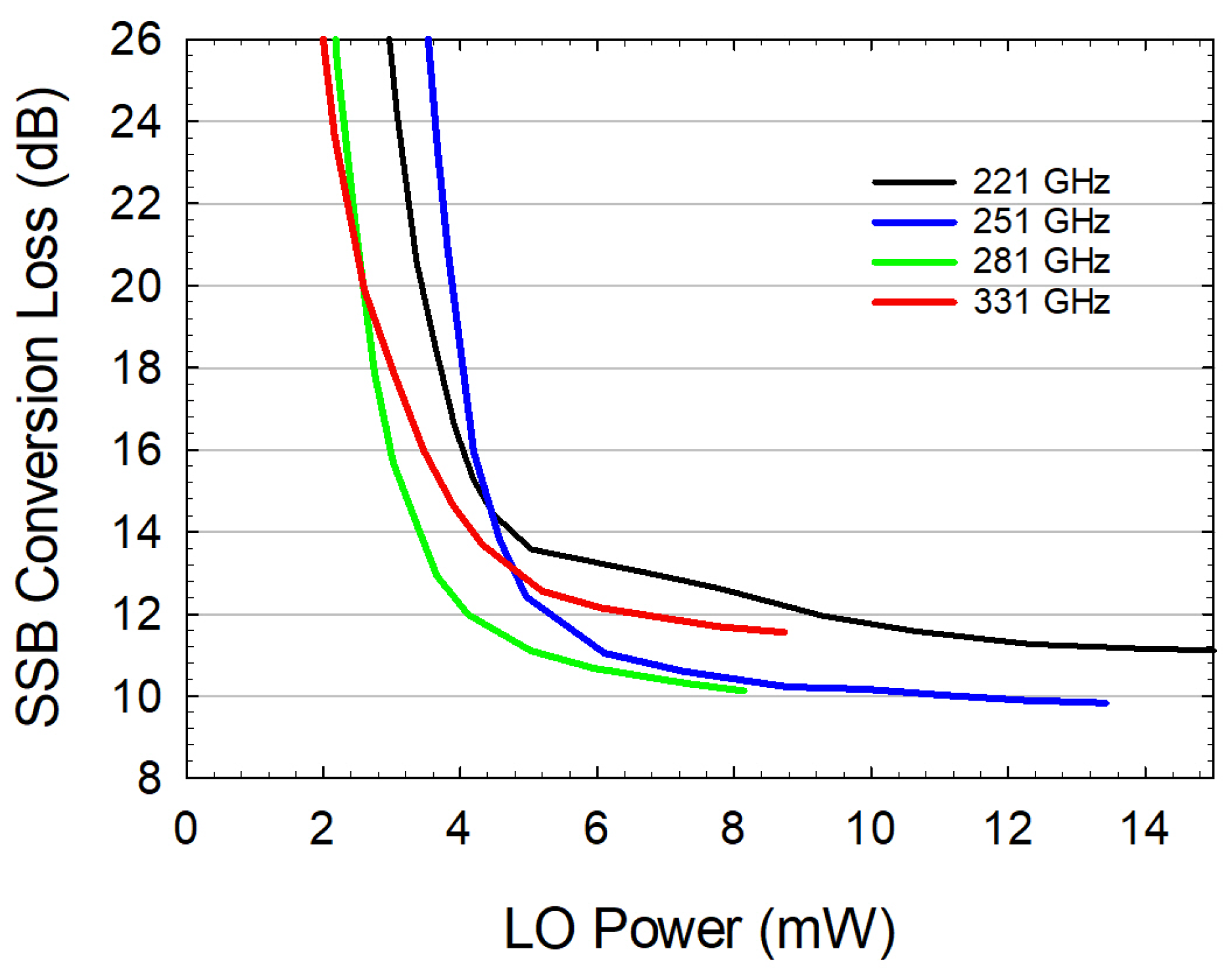

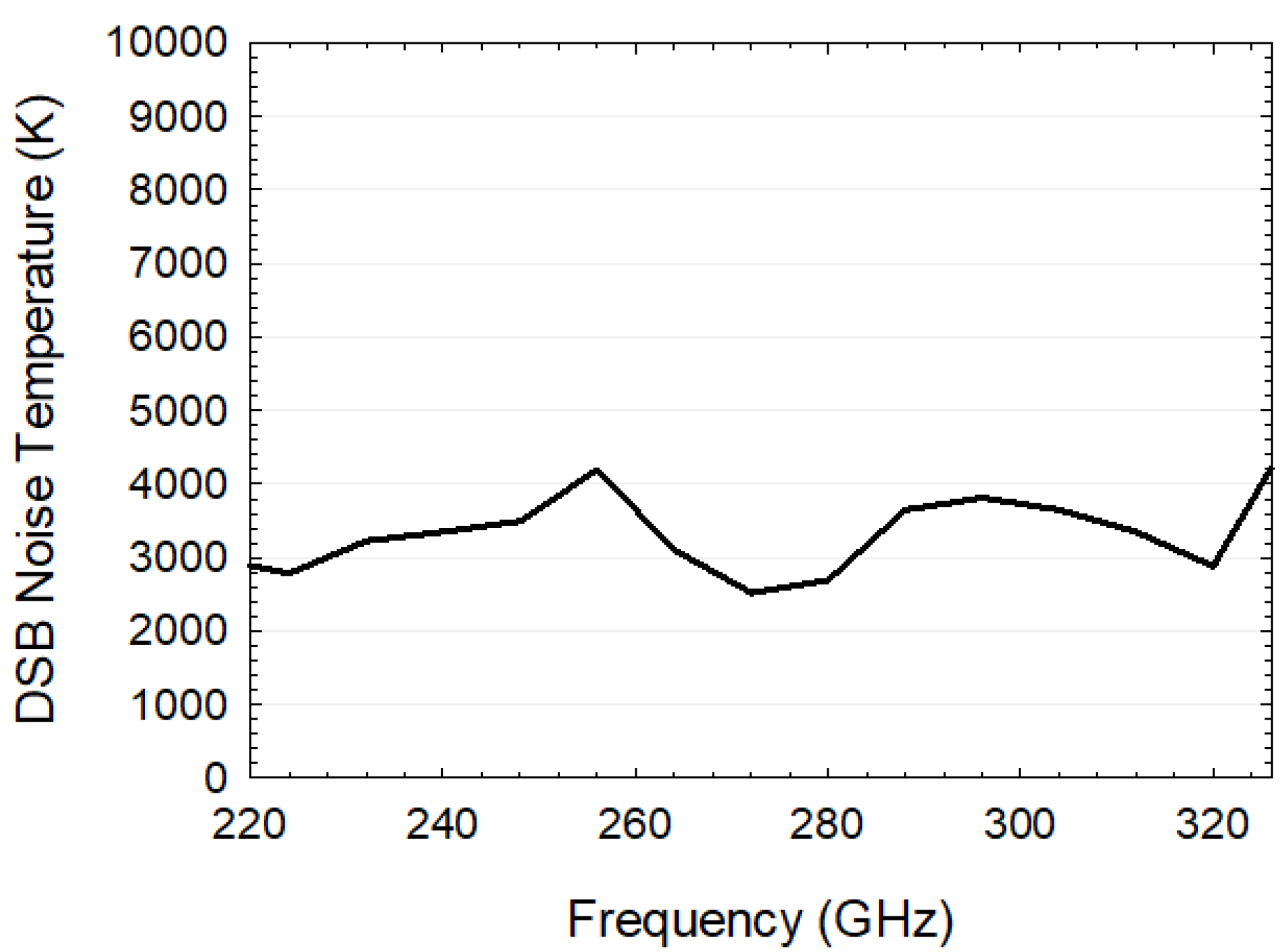



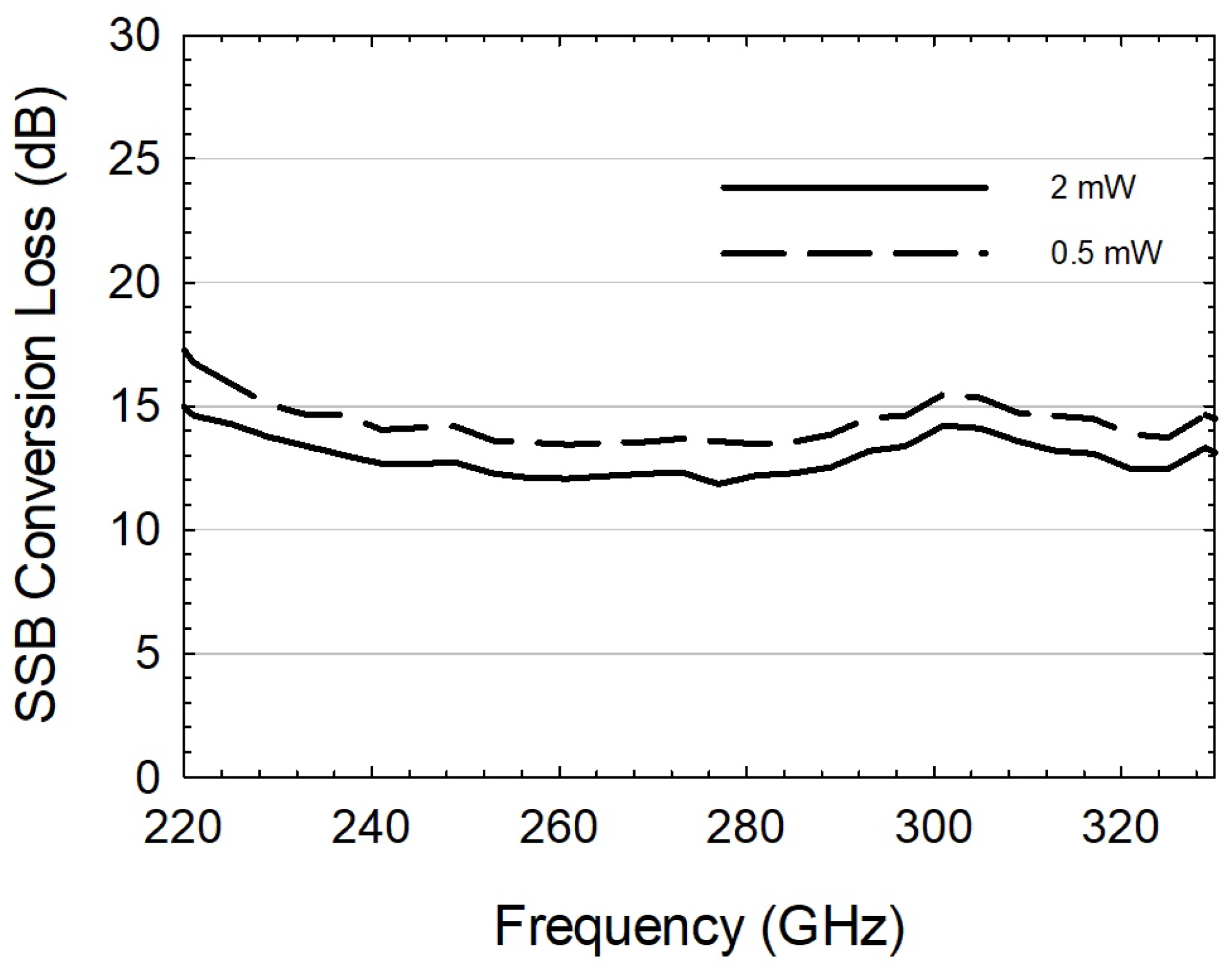
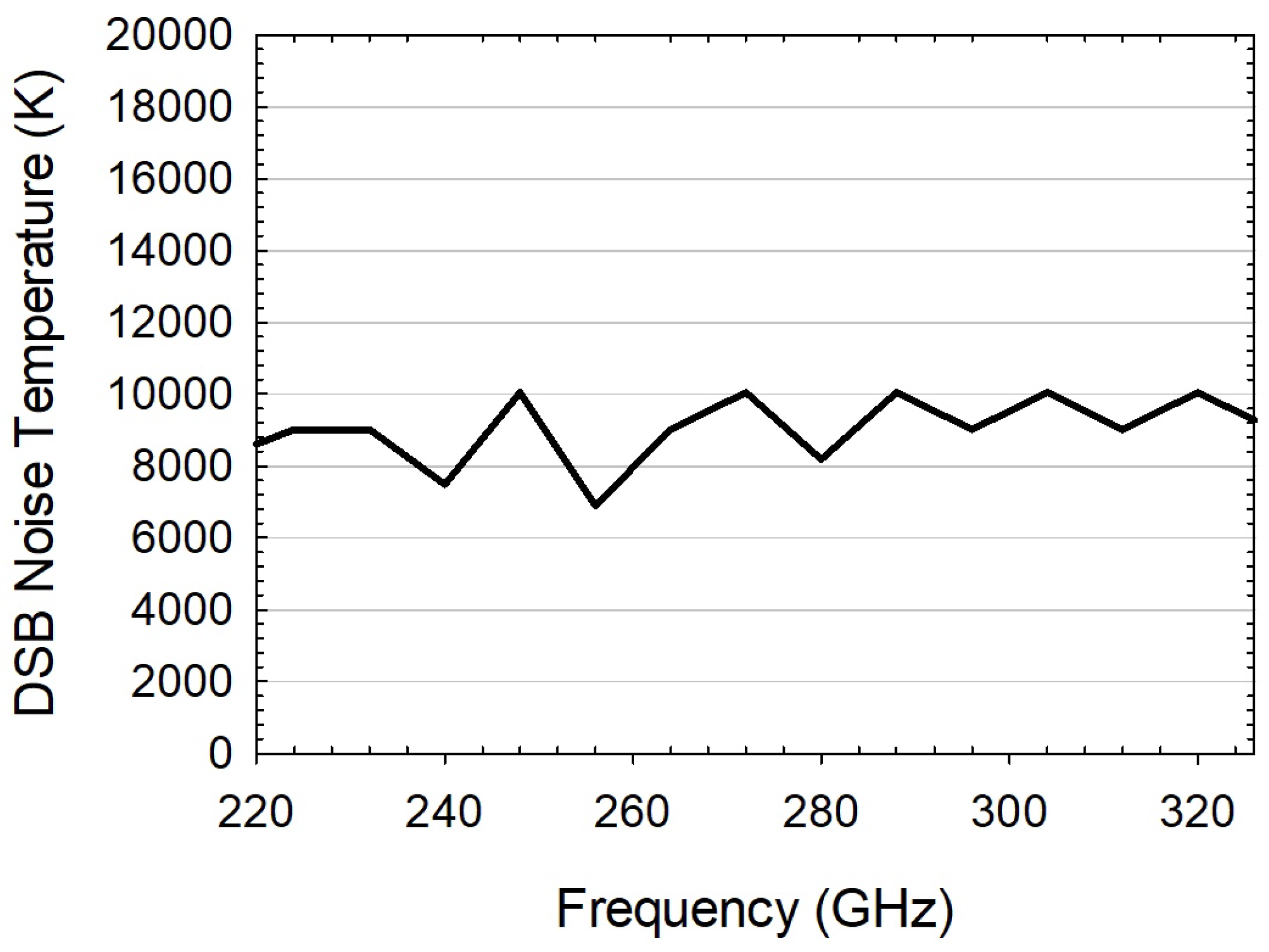
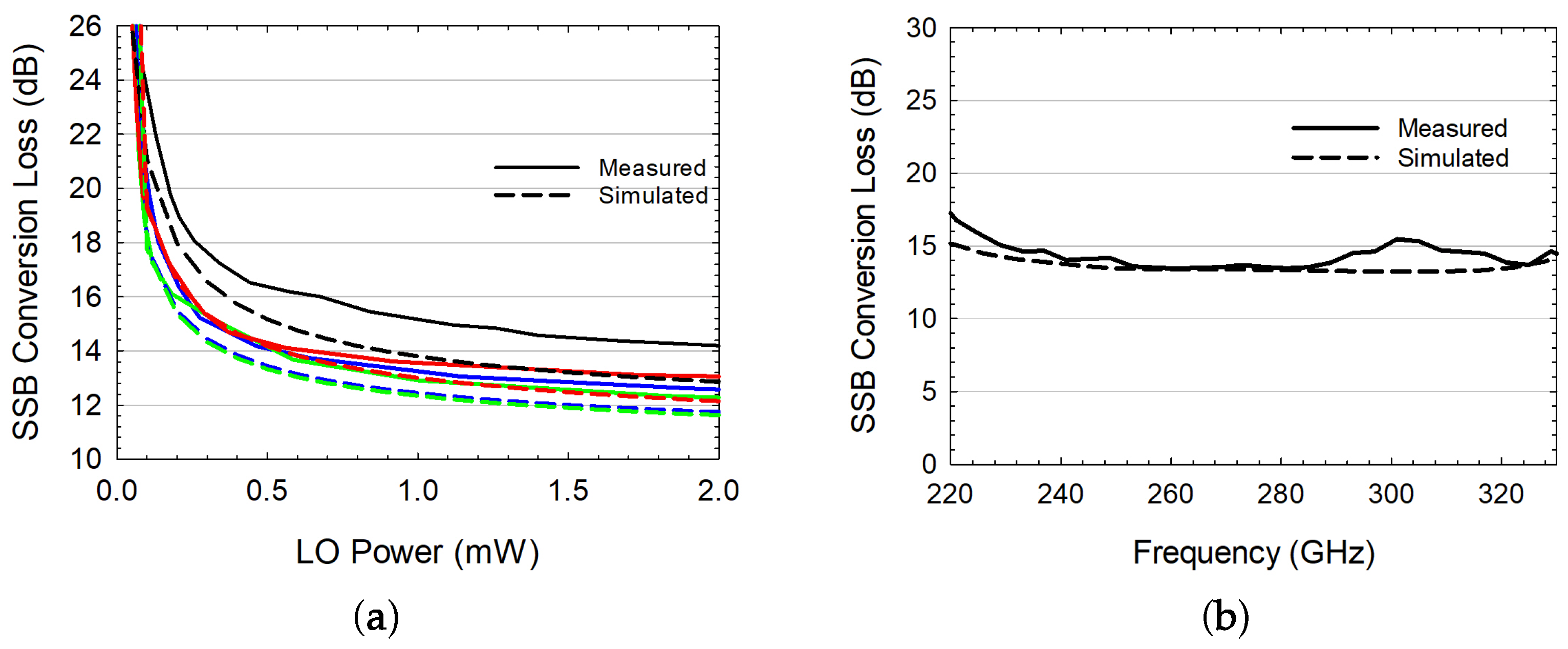
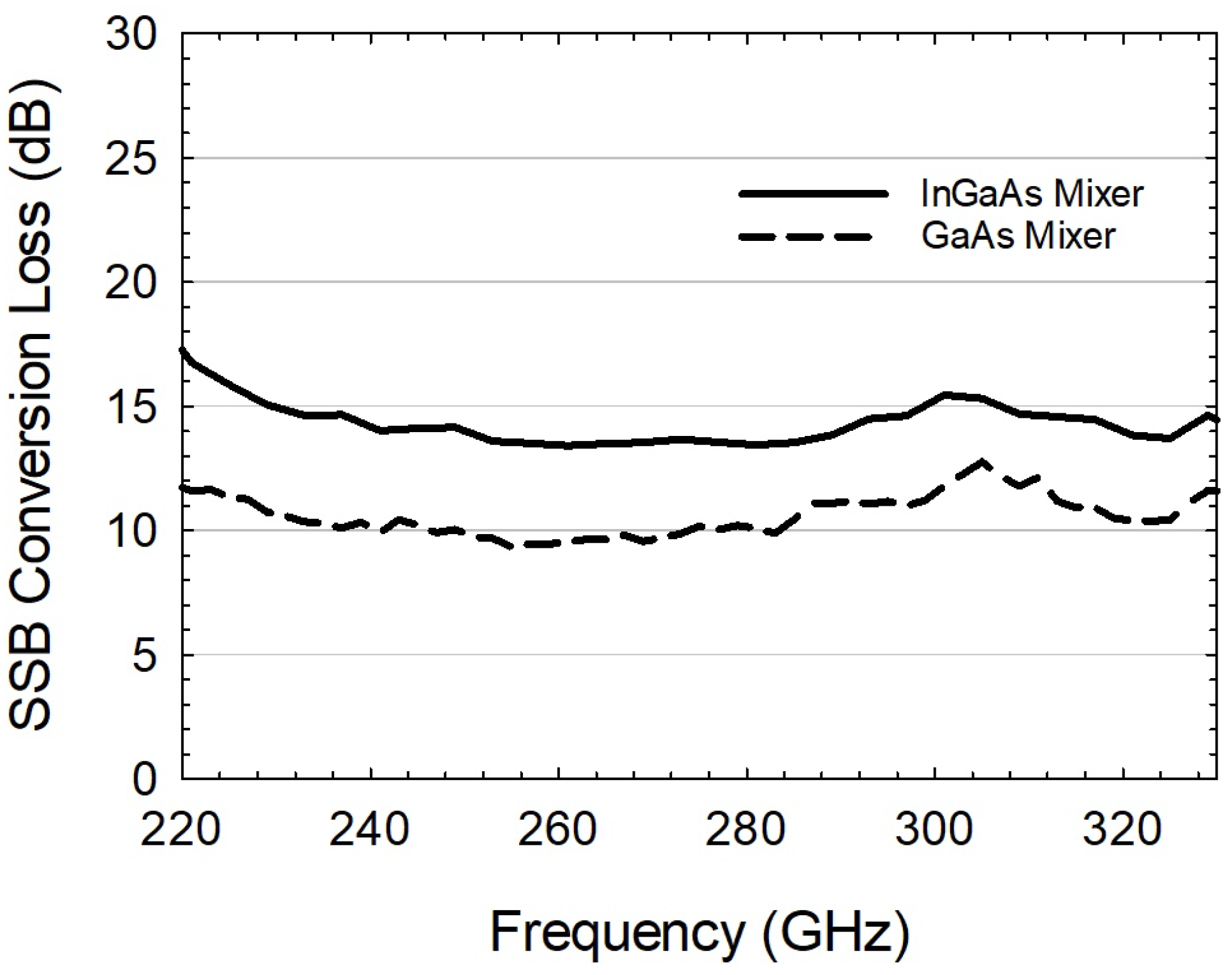
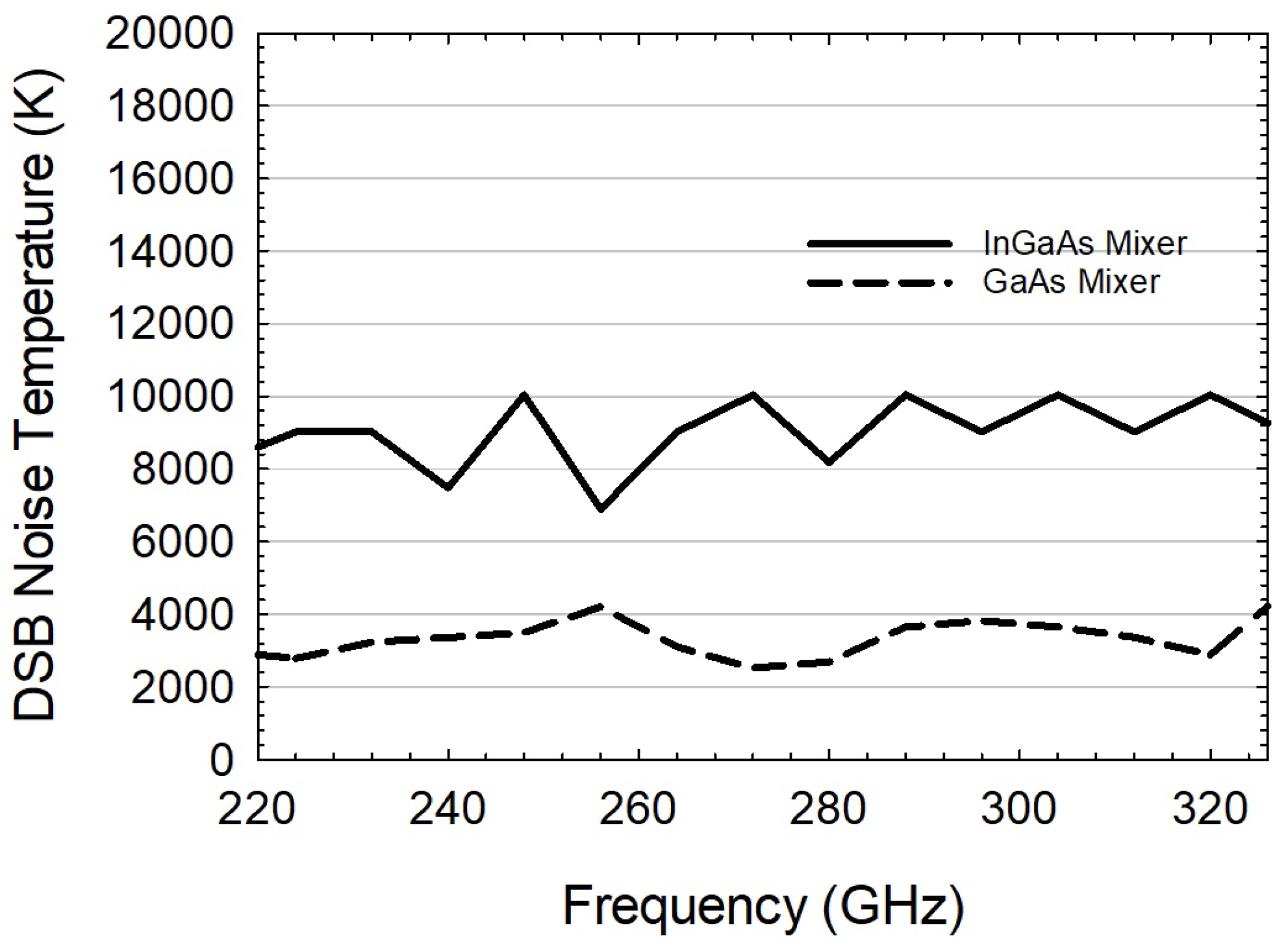

Disclaimer/Publisher’s Note: The statements, opinions and data contained in all publications are solely those of the individual author(s) and contributor(s) and not of MDPI and/or the editor(s). MDPI and/or the editor(s) disclaim responsibility for any injury to people or property resulting from any ideas, methods, instructions or products referred to in the content. |
© 2023 by the authors. Licensee MDPI, Basel, Switzerland. This article is an open access article distributed under the terms and conditions of the Creative Commons Attribution (CC BY) license (https://creativecommons.org/licenses/by/4.0/).
Share and Cite
Martinez Gil, J.; Moro-Melgar, D.; Negrus, A.; Oprea, I.; Cojocari, O. Efficiency Assessment of Traditional GaAs and Low-Power InGaAs Schottky Diodes in Full-Band Mixers at 0.3 THz. Electronics 2023, 12, 4518. https://doi.org/10.3390/electronics12214518
Martinez Gil J, Moro-Melgar D, Negrus A, Oprea I, Cojocari O. Efficiency Assessment of Traditional GaAs and Low-Power InGaAs Schottky Diodes in Full-Band Mixers at 0.3 THz. Electronics. 2023; 12(21):4518. https://doi.org/10.3390/electronics12214518
Chicago/Turabian StyleMartinez Gil, Javier, Diego Moro-Melgar, Artur Negrus, Ion Oprea, and Oleg Cojocari. 2023. "Efficiency Assessment of Traditional GaAs and Low-Power InGaAs Schottky Diodes in Full-Band Mixers at 0.3 THz" Electronics 12, no. 21: 4518. https://doi.org/10.3390/electronics12214518
APA StyleMartinez Gil, J., Moro-Melgar, D., Negrus, A., Oprea, I., & Cojocari, O. (2023). Efficiency Assessment of Traditional GaAs and Low-Power InGaAs Schottky Diodes in Full-Band Mixers at 0.3 THz. Electronics, 12(21), 4518. https://doi.org/10.3390/electronics12214518





